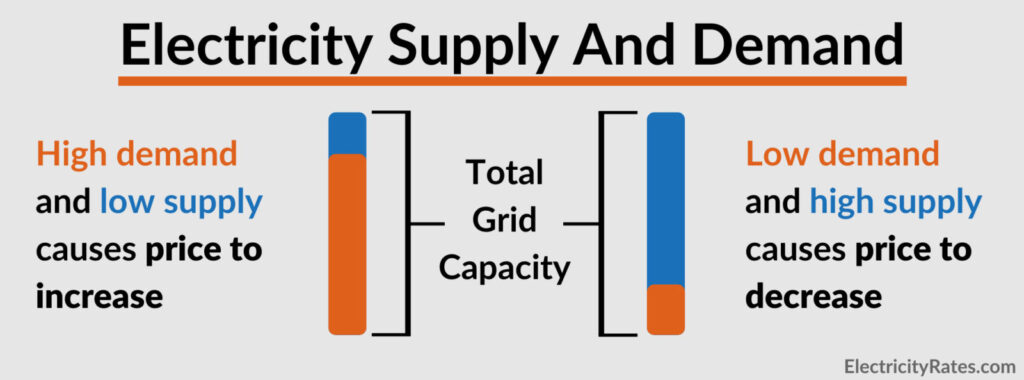The browser you are using is not supported. Please consider using a modern browser.

When Is Electricity The Cheapest?
While a wide variety of factors affect electricity rates, the most dependable one is electricity demand. This page examines how electricity demand works so you can understand when your rates are cheapest.
Electricity Demand
Electricity rates operate on basic supply and demand principles.
As demand increases and supply decreases, the price goes up.
If demand decreases and supply increases, the price goes down.

Electricity grids only have a certain capacity, meaning they can only distribute a certain amount of electricity.
In times of high electricity demand, we use up more of that capacity, meaning a decrease in energy supply. High demand and low supply, causes electricity prices to go up.
In times of low electricity demand, we use less of the grid’s capacity, meaning an increase in energy supply. Low demand and high supply, causes lower electricity prices.
Basically, as electricity use increases, price increases. As electricity use decreases, price decreases.
When Electricity Is Cheapest by Time Of The Year
This can help us show why electricity is cheaper at certain times during the year.
Almost half of all residential energy use comes from heating and cooling your home. So, as you can probably guess, electricity usage (or energy use in general) increases when consumers use their heating and cooling more often.

This is why the winter and summer generally have higher electricity prices. People use more electricity during these time periods.
It is also why electricity is generally cheapest during the spring and fall months when the weather is mild and consumers don’t use their heating and air conditioning.
If you live in a deregulated state, you can avoid these shifts in price by picking a fixed-rate electricity supplier. This means your rate won’t change within your contract’s plan length.
When Electricity Is Cheapest by Time Of Day: Is Your Electricity Cheaper At Night?
For some, electricity prices can change throughout the day. This is called “time-of-day pricing.” You can check your own electricity contract to see if your electricity supplier or utility provider structure their pricing this way.
If they are, you can actually save money if you avoid using electricity during the day.

As people wake up and start their day, electricity consumption increases in what the US Energy Information Administration calls the “morning ramp.” This starts between the hours of 5 AM and 7 AM. If you have time-of-day pricing, electricity prices will increase with this increased consumption.
Throughout the rest of the day, electricity use stays pretty consistent.
Then, as electricity consumers get back to their homes, their electricity use increases even more. It is between these hours, roughly 5 PM to 8 PM, that electricity costs will be the highest. This is called “peak demand.”
After this, electricity consumption slowly decreases and hits its lowest usage at night. That is why the cheapest electricity will be between the hours of 10 PM and 5 AM. This is when electricity usage is lowest.
If you are willing to, that means you can save money on things like washing and drying clothes and doing the dishes, if you do them at night.
Again, make sure your electricity is structured around time-of-day pricing to do this. If it is not, you won’t save any money by using more electricity at night than during the day. You will just be inconveniencing yourself.